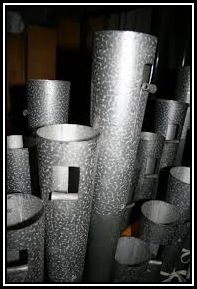THE THEATRE ORGAN
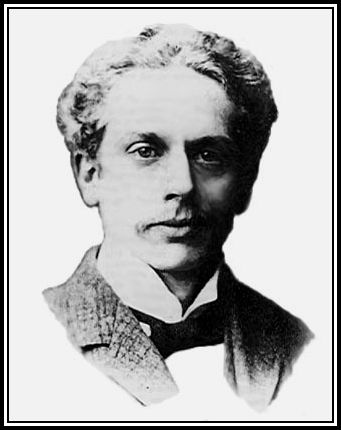 Robert Hope-Jones (1859-1914)
Robert Hope-Jones (1859-1914)
Father of The Theatre Organ
—ooOoo—
Click here to hear Robert Wolfe explain What is a Theatre Organ
—ooOoo—
THIS GLOSSARY IS BASED ON
EVERYMANS CONCISE GLOSSARY OF TECHNICAL TERMS AND COLLOQUIAL EXPRESSIONS
AS APPLIED TO THE MODERN THEATRE ORGAN,
ITS FUNCTIONS AND ATTRIBUTES
BY
EUGENE STUART BARRIE
(and modified by me! ……. together with an occasional mention of the PIPE ORGAN)
—ooOoo—
For those readers wishing to have more information on Organ Stops,
please consult The Encyclopedia of Organ Stops
—ooOoo—
A variety of Organ Stops may be heard at The Virtual Radiogram
—ooOoo—
Readers may also hear some of the Organ Stops of the Longwood Organ,
a Pipe Organ built in 1929, by visiting the website of Longwood Gardens:
for example ……. here is the sound of the French Trumpet
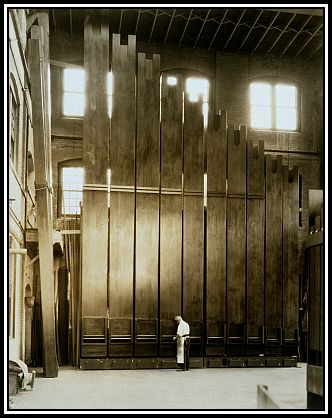 The 32-foot Pipes of The Longwood Pipe Organ in 1929
The 32-foot Pipes of The Longwood Pipe Organ in 1929
The organ was built in The Pipe Organ Factory, Garwood, N.J.
Each year a COMPETITION is held at Longwood Gardens to find the best young organist
and this attracts competitors from all over the world
—ooOoo—
……… Speaking of Stops etc ……. it goes to show how the Theatre Organ Builders could, by means of an elaborate Console with many Stop Keys, fool the public into thinking the Organ was so much larger than it really was. Those small Comptons, the 2/4’s and 2/5’s, only had a couple of hundred pipes and were so very much smaller than the average Parish Church instrument.
PB
—ooOoo—
ACCOMPANIMENT CHAMBER: Please see CHAMBERS.
ACTION: When an organ is played, the Keys, Stops, and Wind Chest work together as a mechanism, known as an Action, to direct pressurised air (i.e. Wind) into the pipes, which produces the sound;
BASS: This is the Pedal Keyboard of the organ and is played with the feet; sometimes an extension into the 16 ft register of one of the Diapason (see below) family;
BRASS SAXOPHONE: This is a reed Stop, which has a brass bell and gives a throaty sound reminiscent of a real Tenor Saxophone. It is useful as a solo Stop or in combination with others.
 Brass Saxophone
Brass Saxophone
(Reproduced from Owen Jones’ Ranks, Virtural Theatre Pipe Organ)
CELESTE or CHRYSOGLOTT: A tuned scale of perfectly tempered steel bars struck by hammers and emitting a harp-like tinkling sound (see GLOCKENSPIEL);
CELLO: A thickly-voiced string Stop, but bearing little or no relation to tone to the violoncello;
CHAMBERS: Theses are rooms containing the sound-producing parts of the organ (i.e. pipework and percussions) and associated items (i.e. wind chests, regulators, building frames etc). The organ speaks from the chambers into the auditorium via the shutters. Theatre Organs are generally totally enclosed in chambers.
Originally – pre-Theatre Organ and Electric Actions when Consoles were actually part of the whole instrument – the GREAT Organ was unenclosed (i.e. no volume control) whilst the SWELL Organ was in a box with shutters, which were opened by the Swell Pedal.
Robert Hope-Jones‘ idea was to put all the Organ’s pipework into one or more chambers, each with a Swell Pedal so that the entire Organ could be volume-controlled. Generally speaking, most English Theatre Organs were of modest size and could be accommodated in two chambers.
The chambers might be:
- under the stage, as with the Odeon Theatre Leicester Square),
- at either side of the Proscenium, or
- at one side, at the Regal Cinema Marble Arch, the Organ was installed in two chambers to the right-hand side of the Proscenium with one on top of the other; or
- on the left-hand side of the Proscenium, again with one on top of the other.
Usually, the SOLO chamber has what are regarded as the Solo Stops, i.e. those capable of picking out a distinctive melody, such as Tuba, Trumpet etc whilst the ACCOMPANIMENT chamber has the softer stops, i.e. Violin, Celeste and Diapason. Therefore an organist might play the melody on the Trumpet via the Great manual with the right hand and the accompaniment or harmony with the Violin and Flute on the Accompaniment manual with his left hand.
This is not exhaustive, as an Organ can have as many chambers as are available. The Fox Theatre San Francisco WurliTzer Theatre Organ had its 36-ranks in five chambers. In some other cases, chambers were not named as Solo, Accompaniment etc, but were simply labelled with numbers 1-10 etc, however this is not an exact science.
An advantage of having chambers next to one another is that it allows a reduction in the amount of WIND-TRUNKING necessary. See WIND-TRUNKING;
CHIMES: This is a percussion stop consisting of real bells or tubular chimes, struck by hammers.
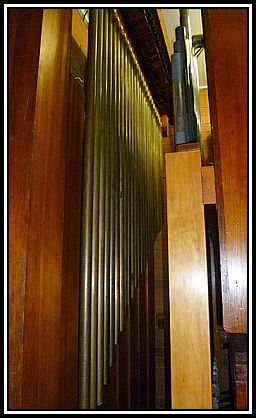 Chimes
Chimes
(Kevin Grove State College, Queensland)
CINEMA ORGAN (UNIT ORGAN): The Theatre, Unit or Cinema Organ is a distinct type of Pipe Organ developed for a specific purpose, which was to entertain an audience and grew to be a unique instrument;
CLARINET: The only Stop in the organ which comes nearest in fidelity to sounding exactly like the orchestral instrument of the same name;
COLOUR: See Rank;
CONSOLE: The massive case encompassing the Keyboards, Stop Tablets and the activating circuits and mechanism that set in operation everything pertaining to the organ.
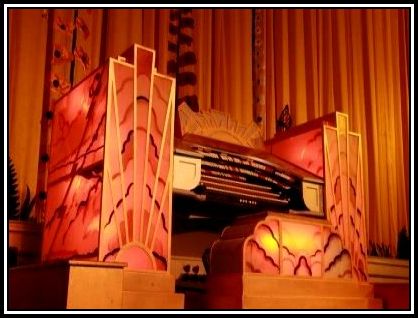 The Compton Organ Console installed at the Plaza Stockport
The Compton Organ Console installed at the Plaza Stockport
Click here to hear the Plaza Compton Organ
Click here and here
to hear the Compton Organ of the Odeon Leicester Square, known as The Duchess
COUPLER: This allows the Stops of one division (i.e. a series of Ranks) to be played from the keyboard of another Division (see below); in addition, see INTER-MANUAL COUPLERS, QUINT and TIERCE below;
CRESCENDO PEDAL: The last of a row of control-pedals (situated directly above the pedal keyboard), and which gradually brings on the full organ when depressed by the organist;
DIAPASON: This consists of a number of Stops of the organ i.e. Open Diapason, Stopped Diapason, Horn Diapason, String Diapason and Diaphonic (Diaphone) Diapason. This is the truly representative Stop family of the organ proper, which, in the gradual evolution of the Pipe Organ, has sired many other Stops, now either obsolete or transmuted into other Ranks (a Rank is a Stop or a Set or Pipes; if an organ has 25 Ranks, it has 25 Sets of Pipes);
Suffice it to say that the Diapason (Untremulated) is the authentic foundation of the Pipe (Church or Classical) Organ in all its varied aspects i.e. the Diapason IS the organ, while in the case of Cinema or Theatre Organ, the distinctive sound is produced by the Tremulated Tibias Clausa.
 Open Diapason
Open Diapason
(Reproduced from Owen Jones’ Ranks, Virtual Theatre Pipe Organ)
Click here to watch John Leeming’s video, Troxy: Elevating a Diaphone Resonator
DIVISION: A collection of Ranks (i.e. a set of Pipes) that are controlled by a particular Manual (i.e. keyboard) is called a Division. The names given to these Divisions include: Great, Swell, Choir, Solo Orchestral, Echo etc.
DRAW STOP: specifically used to control the Stops of a classical, or church organ. So-called because the action of pulling, or drawing the stop permitted air to flow to the pipes;
DULCIANA: The softest sounding member of the Flute family, voiced so as to give off a very ethereal tone;
DUPLEXING: the American term for Extension;
ENCLOSURE: This refers to a system that allows for volume control without requiring the addition or subtraction of Stops (see Expression Pedal). The pipes of a Division may be surrounded by a box-like structure (i.e. the swell box), which is built with horizontal wood flaps (i.e. palettes) that may open and close following direction by the organist at the Console. When the flaps are open, more sound will be heard and less when closed;
ENGLISH HORN: Despite its name, this stop bears little relation in tone or body to the Cor Anglais (English Horn); apparently it is suggested that this Stop should be known as the Double English Horn since it more properly belongs to the heavy brass family of the organ. With an 8-foot register, it can be made to sound both melodious and sharp biting and with a 16-foot register, it can emulate the Bass Slide Trombone. This stop was mainly found with the large American-type Wurlitzer Organs;
EXPRESSION PEDAL: This is a pedal associated with Pipe and Theatre Organs, as well as electronic keyboards. Since the source of power with an organ is not produced by the organist, the volume produced has no relationship to how hard a key or pedal is struck. In addition, the tone will remain constant in pitch, volume and timbre until the applied pressure to the key or pedal is removed. The Expression Pedal gives the organist control over the external source of power, and thus the volume, while leaving the hands free;
EXTENSION: This is the method of adding extra octaves to a Rank of pipes to enable it to be available at different pitches, via selective electrical control; also see DUPLEXING;
FLUTE: This stop has many uses and is an integral part of the Theatre Organ and has many relations, such as: Concert Flute, Harmonic Flute, Echo Flute, Transverse Flute, etc. The Flute with clever manipulation is very near in tone to the flute of the orchestra. It has many uses and is an integral part of the Theatre Organ;
GAMBA: This is a sharply-voiced string stop with a nasal biting quality. Its tone bears some resemblance to the ancient instrument, Viola da Gamba, from which it derives its name. A Viol is a string instrument that is larger than a violin and played while seated and supported between the legs. It was developed in Europe in the 15th Century and used mainly in Renaissance and Baroque periods.
 Gamba
Gamba
(Reproduced with permission of The Cinema Organ Society)
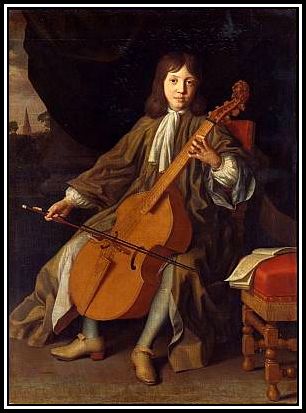 Bass Viola da Gamba by Edward Lewis, 1687
Bass Viola da Gamba by Edward Lewis, 1687
GLOCKENSPIEL: This is a tuned set of metal bars on the same principle as the CHRYSOGLOT, but with a more attenuated tone;
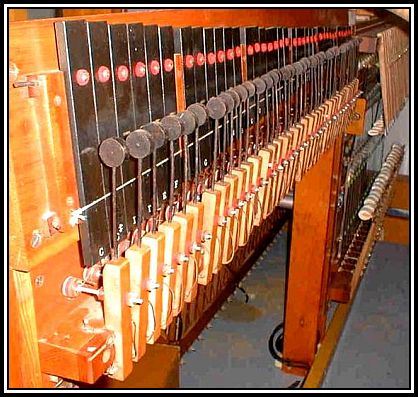 Glockenspiel
Glockenspiel
(The Organ of the Dome Concert Hall, Brighton)
GRAND JEUX (GREAT PLAY): The full complement of the organ brought into play at once by the use of the Crescendo Pedal;
INTRA-MANUAL COUPLERS: these are Stops that couple manuals (keyboards) together. For example, SOLO TO GREAT: whenever STOPS are selected on the SOLO MANUAL, they will also sound on the GREAT MANUAL (together with those Stops already selected on the GREAT) should the appropriate INTRA-MANUAL COUPLER be engaged;
INTER-MANUAL COUPLERS: these include Stops like Octave and sub-Octave. When a note is played only that note particular sounds. When the Octave Coupler is engaged, one also has the same note being played at an octave higher. Similarly, when the sub-Octave Coupler is engaged, the note an octave lower will also play;
KINURA: This is s a small, bright and buzzy sounding reed at only 8-foot pitch and can be used in conjunction with strings or Flute/Tibia to produce a variation in sound. It is a useful Stop, but an not essential one.
 Kinura
Kinura
(Reproduced from Owen Jones’ Ranks, Virtual Theatre Pipe Organ)
KRUMET: This stop sound like a fluttering vibrating reed, which is distantly allied to the Russian Oboe family. It can blend well with the string ranks and so give the effect of an additional string-colour ensemble;
MANDOLINE: The effect of a Mandolin is produced by allowing metal tongues (one for each note) to come lightly into contact with the piano strings so as to vibrate with them and give the characteristic tang to the tone;
MANUAL: This is the name given to any Keyboard of an organ:
MARIMBA, MARIMA HARP, MARIMBAPHONE: Whether large or small scale, these stops are found mainly in large Theatre Organs. They consist of graded wooden bars, somewhat larger and fatter in tone than those of the Xylophone and each note is accompanied with a resonating metal tube underneath. In large American Organs, the small-scale Marimba Harp is always under expression inside one of the organ chambers, and the large-scale Marimbaphoneis placed outside the organ, usually on an artificial balcony directly outside the organ-grille. The Marimba is a national instrument of a number of South America countries and was first introduced as percussions in the modern Theatre Organ by Robert Hope-Jones;
MELOTONE: This is a device fitted to the Compton Theatre Organ, which provided new tonal effects by purely electrical means. Whether used alone or in combination with pipe ranks, it furnished tone colours otherwise not available. Expression was given by the normal use of the Swell Pedal and Tone could be made to die away gradually by the Echo Control;
MUSETTE: This is an ancient, reed-like stop of many over-spilling overtones allied to the Krumet, but of more rasping texture;
MUSIC DESK: This is a structure that is found on the front of the Console on which sheet music is placed for the player to read and perform. It was frequently ornamental and was often used to advertise the Theatre Organ’s manufacturer. Not all theatre and cinema owners approved of this form of free advertising and insisted that their instruments be installed with plain Music Desks; this information was provided by Mr. Anthony Storey;
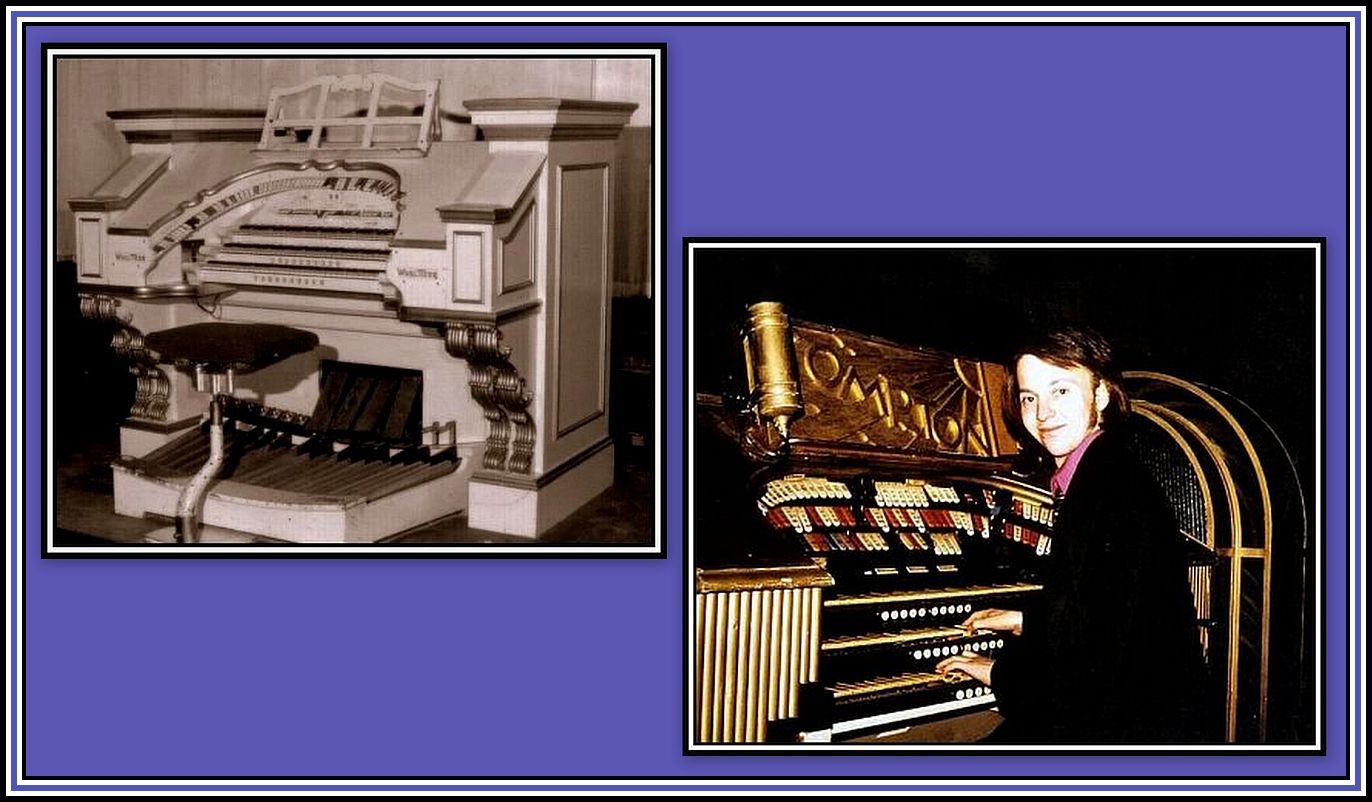 Left: The Wurlitzer Console of the Granada Theatre Slough – note the plain Music Desk; Right: Andrew Gilbert at the Compton Theatre Organ, Plaza Theatre Sutton in 1974; this photograph was taken by Ms Andrea Easton Gilbert – note the name of the manufacturer associated with the Music Desk
Left: The Wurlitzer Console of the Granada Theatre Slough – note the plain Music Desk; Right: Andrew Gilbert at the Compton Theatre Organ, Plaza Theatre Sutton in 1974; this photograph was taken by Ms Andrea Easton Gilbert – note the name of the manufacturer associated with the Music Desk
OBOE (HORN & ORCHESTRAL): The Oboe Horn is neither an Oboe nor a Horn. It has a delicate Fluegelhorn or very soft French Trumpet sound. The Orchestral Oboe has little similarity to the Oboe of an orchestra and has a raspy or strident tone according to how it is voiced.
 Oboe Horn (Wurlitzer)
Oboe Horn (Wurlitzer)
(Reproduced with permission of The Cinema Organ Society)
PEDALS: The Pedals, the Pedal-Keyboard of an organ, are played by the feet;
PIPE, CLASSICAL, STRAIGHT ORGAN: This is a musical instrument that contains one or more sets of pipes, a Wind system and one or more Keyboards (Manuals). It is commonly used in churches, cathedral and recital halls.
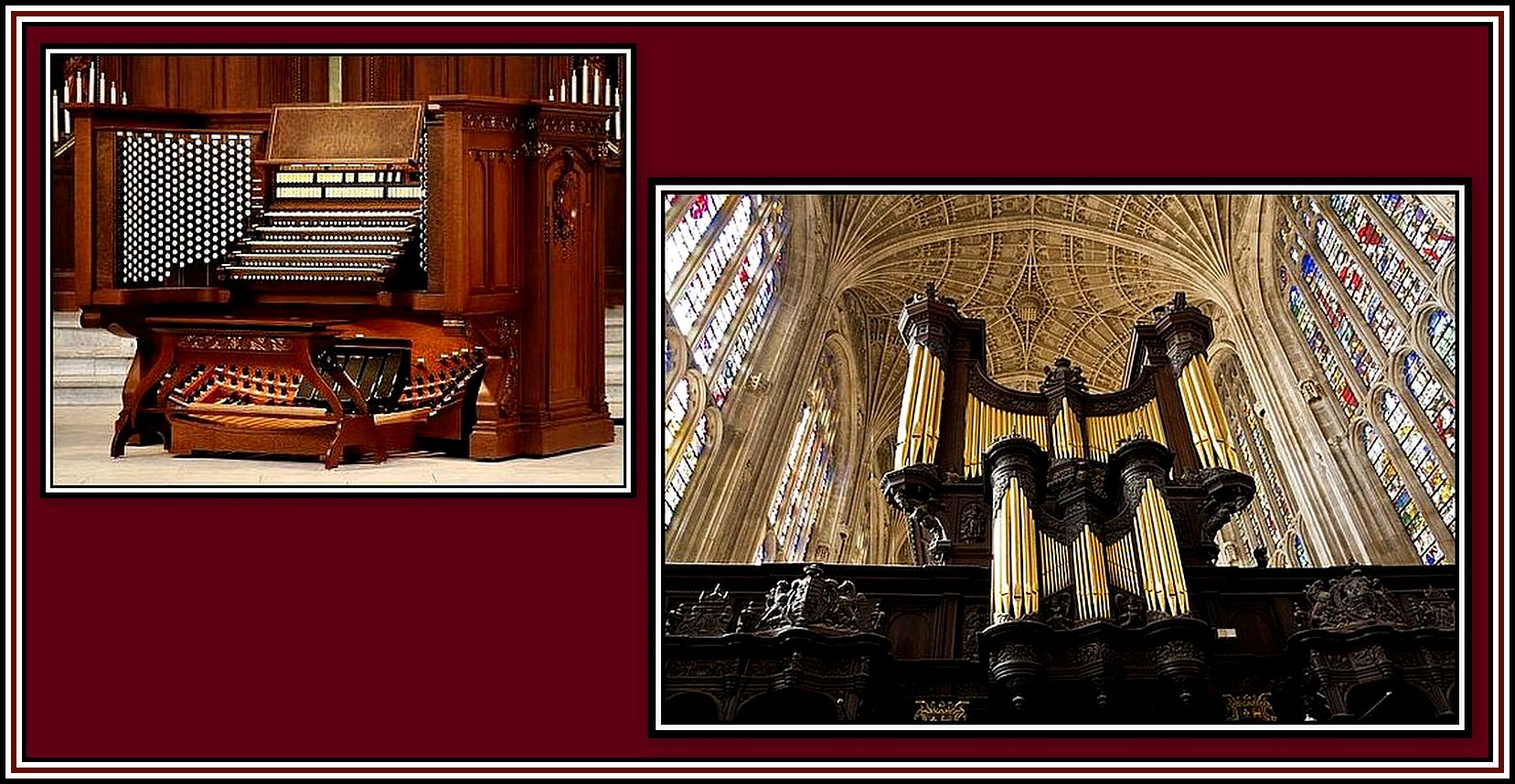 Keyboards & Pipes of a Church Organ
Keyboards & Pipes of a Church Organ
Left: the Console of the Organ of the U.S. Navel Academy Chapel (5 Keyboards; 522 Drawknobs)
Right: Organ Pipes, Kings College Chapel, Cambridge
PITCH: Pitch is an auditory sensation in which a listener assigns musical tones to relative positions on a musical scale based primarily on the frequency of vibration. Pitch is closely related to frequency, but the two are not equivalent. Frequency is an objective, scientific concept, whereas pitch is subjective;
PNEUMATIC (or MOTOR): A pneumatic is effectively a tiny bellows made of two pieces of wood joined by thin leather gussets, which opens and closes the valve (also called a pallet) that allows pressurised wind to enter the bottom of a pipe. In Wurlitzer Organ WIND CHESTS, there are typically two pneumatics: a primary and a secondary pneumatic. The use of double pneumatics ensures a fast action when high wind pressure is employed, as is the case with the Theatre Organ. A pneumatic or motor may be either filled with air or emptied of it. When emptied, the pneumatic is said to have been exhausted.
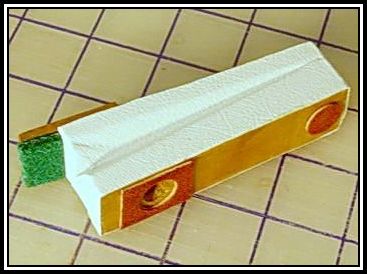 A Pneumatic
A Pneumatic
This photograph appears with permission of Mr. Simon Glenhill
QUINT & TIERCE COUPLERS: When the QUINT (meaning five) COUPLER is engaged, a note one fifth higher is played. For example, if the C-note is played with the QUINT COUPLER engaged, the G-note above will also sound. The TIERCE COUPLER works in a similar manner, but engages a tenth above the note engaged. Therefore, if the C-note is played with the TIERCE COUPLER engaged, the E-note will sound from the octave above (i.e. ten notes);
RANK (also called COLOUR or VOICE): This is a common term denoting each Stop (or Set of Pipes) in its entirety (i.e. an organ with 25 Ranks therefore has 25 Sets of Pipes);
REGISTRATION: This is the general term for the technique of choosing and combining the Stops of an Organ in order to produce a particular sound. It can also refer to a particular combination of Stops. The Registration chosen for a particular piece will be determined by a number of factors, including the composer’s indications (if any are given), the time and place in which the piece was composed, the organ the piece is played upon, and the acoustic in which the organ resides;
RELAY: This may be considered as the brains of the organ and likened to a primitive computer system. It consists of a number of switches that transmit the actions of the organist at the Console to the Pipe resulting in sound being produced (i.e. a note being played). The Relay allows the organ Console to no longer be directly and mechanically connected to the pipe chests.
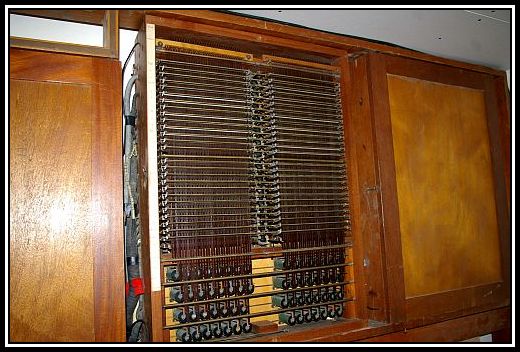 Part of the Relay System of the Compton Theatre Organ
Part of the Relay System of the Compton Theatre Organ
once installed at the Granada Theatre Dartford
(This photograph appears with permission of the photographer, Mr. Wayne Ivany)
RESERVOIR (Wind): This is that part of the organ that supplies the air (i.e. Wind) where needed, whether for mechanical induction or the sounding of a Pipe;
SALICIONAL: This is a String Stop, in that it represents the strings family of instruments in the orchestra;
SAXOPHONE: This is a highly individual and acoustically temperamental reed in the modern Theatre Organ. It has little resemblance to its orchestral counterpart, whether in shape or sound, it can be so constructed and voiced as to give a haunting crooning tone somewhat like that of the orchestral melody saxophone employed in dance bands. To obtain the best effect, it was generally constructed of brass, with brass tongues and provided with its own chest and individual Tremulant. Later, it was constructed with metal alloys and phosphor-bronze tongues and operated with less Wind. This served to deprive it of its rich crooning tone and reduced its timbre and salient quality;
SOLO CELLO: was an amplified cello string whereby a rotating resin wheel touched the string as soon as this stop was applied. Mechanical fingers at the desired harmonic points touched the string as the notes were played. Due to the complexity of this device it was prone to failure and also impossible to keep in tune with the rest of the organ which is most probably why it fell out of favour almost from the start and was replaced by a Melotone.
SOLO CHAMBER: Please see CHAMBERS.
SOUND BOARD: an airtight wooden chest, or box, fed with wind from the organ blower, upon which individual sets of organ pipes may be mounted. A soundboard may contain only one, or several different sets of pipes; also see WINDCHEST;
STOP, STOP KEYS: An organ Stop is a component of a Pipe Organ that admits pressurised air (Wind) to a set of organ pipes (Ranks). The Ranks of the traditional Pipe Organ are turned on and off by Draw Knobs placed on panels on both sides of the manuals. For the Theatre Organ, Robert Hope-Jones substituted the Draw Knobs with electrically operated tongue-shaped Stops (Tablets, Stop-Tabs, Tabs, Stop-Tablets) positioned on a curved panel set around and above the Manuals (Horseshoe Console) to control the pipes, percussion instruments, effects (e.g. Tremulants) and couplers. Its name derives from the fact that Stops may be used selectively by the organist – some may be in the on position (admitting the passage of air to certain pipes) while others may be off (stopping the passage of air to the other pipes).
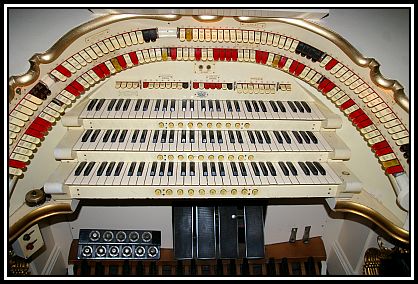 The Horseshoe Console of the Wurlitzer Organ installed at the Opera House Blackpool
The Horseshoe Console of the Wurlitzer Organ installed at the Opera House Blackpool
showing the Stop Tabs above and around the Manuals (Keyboards)
STOP RAILS: Stop Keys are not attached to the Keyboards as such, but to the Console. The curved sections of the Horseshoe Console containing the Stop Keys are called the Stop Rails.
STRAIGHT ORGAN: This is an organ where all Stops of pipes in each department or keyboard are supplied with wind by a common mechanism to all of them. It is a term for an organ that is neither Tremulated nor Unified, i.e. a Church, Town Hall or Classical organ;
SWELL BOX: on the classical or church organ, a soundproofed box containing the pipes of the Swell Organ. In the Theatre Organ, all pipes are contained within Swell Boxes so volume control of the entire instrument is possible;
SWELL PEDAL: This is any of a group of foot-controlled levers situated directly above the Pedal keyboard, each one of which governs the expression (softness and loudness) of the organ by opening or closing the various shutters in front of the organ chambers. On some organs, they were linked together to be operated from a general Swell Pedal;
SWELL SHUTTERS: the louvres which open or close on one side of the Swell Box;
TABS, TABLETS, STOP-TABS, STOP-TABLETS: The Stop-Tablets are set into the Console in semi-circular form, each one of which controls a Rank (Set of Pipes) in the organ or otherwise brings into play the effect desired; the term, Tabs, is also used to denote stage curtains;
THEATRE ORGAN (UNIT ORGAN): The Theatre, Unit or Cinema Organ is a distinct type of Pipe Organ developed for a specific purpose, which was to entertain an audience and grew to be a unique instrument.
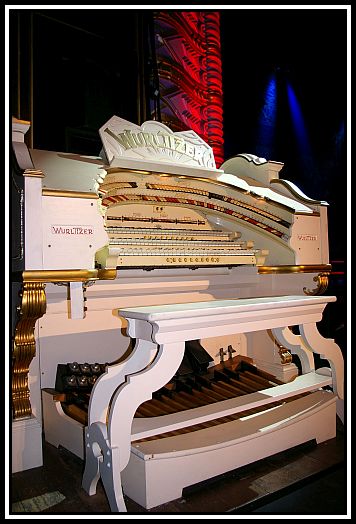 The Mighty Wurlitzer at the Opera House Blackpool
The Mighty Wurlitzer at the Opera House Blackpool
and was the last new Wurlitzer Organ to be installed in Britain
(The photograph is reproduced with the permission of Mr. Wayne Ivany)
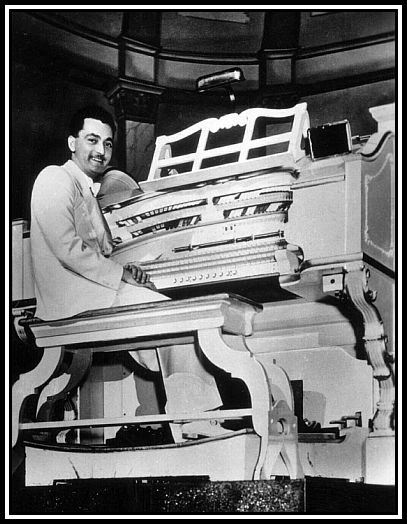 Click here to hear Reginald Dixon, Mr. Blackpool,
Click here to hear Reginald Dixon, Mr. Blackpool,
playing the magnificent instrument at the Tower Ballroom Blackpool
Click here to watch a short video on The Theatre Organ
made by the The Theatre Organ Society of Australia NSW
TIBIA, TIBIA CLAUSA, TIBIA PLENNA, TIBIA MINOR etc: The Tibia Clausa is considered to be the most beautiful Stop in the modern organ. It is often identified with the Flute family, but it was originally identical with the Greek Aulos and played by means of a reed mouthpiece, which gave it a hollow windy tone of marked melancholy. Today, it is either a large wooden Pipe (as with Wurlitzer Organs) or a tin-lead alloy (as with Compton Organs), much like an overgrown concert flute, which requires its own chest and Tremulant (see below) to achieve its mournful singing quality. Apparently it was very sensitive to acoustics and had to be given a great deal of Wind in order to obtain its characteristic harmonic overtones, thereby making it a difficult Stop to tune.
As stated earlier, it is the Tremulated Tibia Clausa that gives the Theatre Organ its distinctive sound, while Untremulated Diapasons give the Pipe (Church or Classical) Organ its characteristic sound.
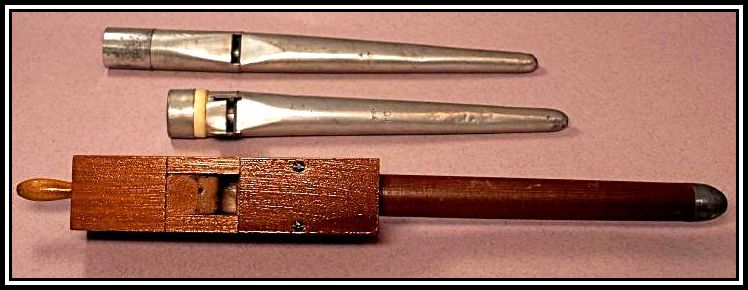 Comparison of different Wurlitzer Tibia Pipes
Comparison of different Wurlitzer Tibia Pipes
all from the same Rank – wooden, capped and open
(Reproduced with permission of The Cinema Organ Society)
TIERCE COUPLER: see QUINT COUPLER above;
TRAPS: These comprise all the un-pitched percussions in the organ. A general complement contains the following: Bass Drum, Snare Drum, Tambourine, Castanets, Triangle, Wood Block, Chinese Gong and Sleigh Bells etc.
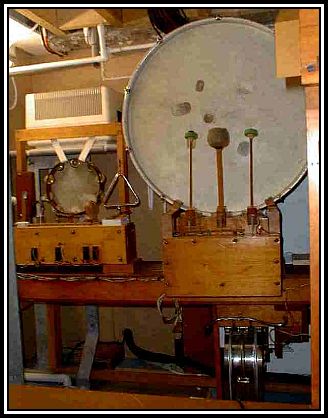 Toy Counter showing the Tambourine, Triangle & Drum
Toy Counter showing the Tambourine, Triangle & Drum
(The Organ of the Dome Concert Hall, Brighton)
TREMULANTS, TREMS: These are self-contained chest-unit (often as many as 10 or 15 for the various Ranks) which, when set in operation at the console, impart the effect of a vibrato (slow or fast according to the manner of regulation), thereby giving a singing quality that is characteristic of the Theatre Organ. Later, most Theatre Organs had Trems on all of their Ranks including Tubas and Diaphones;
TUBA: This is a life like Stop, which is usually available from 4-foot pitch, when it usually named Clarion, down to 16-foot pitch on the Pedal (and sometimes to 32-foot). It is a very useful Stop being smoother than a Trumpet and is to be found in virtually all Theatre Organs from the smallest to the largest. Variations are Tuba Mirabilis (louder,) Tuba Horn and Harmonic Tuba, but the basic Tuba is invaluable as an ensemble stop and as a nice round, fruity solo Stop.
UNIFICATION (UNIT-ORGAN; THEATRE ORGAN): This is the term used to describe the modern organ design whereby a certain number of Ranks are distributed and duplicated in various ways over all manuals, instead of being isolated in separate groups. This allows for greater flexibility and diversity, as not only is it possible to draw the various Stops at different pitches, but it enables the organist to use the same Stop with different combination of registration on any of four manuals, especially in the more elaborately unified instruments;
VIOLIN CELESTE: This Stop is a Violin Stop that is tuned slightly flat (see WAVE below);
VOICE: See Rank;
VOX HUMANA: This is a very throaty Rank, thinly resembling the character of the human voice, but more of the body of a heavily-shaken Celeste-string. It is subjected to a marked vibrato (it has at all times its own Tremulant), and although its acoustic power is limited, it is capable of cutting many times its own weight. As a Stop in the organ, it is unique.
 Vox Humana (Wurlitzer)
Vox Humana (Wurlitzer)
(Reproduced with permission of The Cinema Organ Society)
WAVE: In order to achieve a wavering quality (i.e. a Celeste effect) between two identical Stops – e.g. two violin Stops – one Stop is tuned slightly flat. This causes it to shake or lean towards the other, and they are then designated, respectively Viole and Viole Celeste. In the case of other Stops so tuned, the same applies, i.e. Flute, Flute Celeste;
WIND: Sound is produced when pressurised air (i.e. wind) is driven through an organ pipe. Wind pressures vary from rank to rank and from organ to organ, and are a matter of taste, as are tremulant settings. Theatre Organ wind pressures are much higher than church organs. In addition, higher wind pressure equates with increased loudness. American Theatre Organs are generally played at higher wind pressure, often between 10 and 50 inches of water pressure while those in the U.K were maintained at lower pressures. For example, the Wurlitzers Organs of the Granada Theatre Tooting and the Gaumont Cinema Manchester both included two Tibias: the solo and the main, which was part of the accompaniment, with the solo Tibia on 15 inches of water pressure and the main, on 10 inches. This difference allowed the main Tibia to blend (i.e. accompany) with the sounds from other stops. Today, since many Theatre Organs are housed in smaller buildings, the wind pressure may be decreased to produce a sound that is more acceptable to an audience. Wind pressure may be as low as 8 inches of water pressure however the average seems to be more in the region of 10 inches. Employing lower wind pressures impart a more refined quality to the organ and solo stops can be used with small accompaniment registrations and thereby offer more variety from smaller organs;
WIND CHEST: The Wind Chest consists of long wooden boxes on which the pipes sit and which contain an array of valve mechanisms (i.e. the action) for admitting air to each pipe; also see SOUND BOARD;
WIND-TRUNKING: An advantage of having chambers (see CHAMBERS) next to one another is a reduction in the amount of Wind-Trunking necessary. Wind Trunking refers to the system of pipes or conduits used to connect the wind supply from the Blower to the Organ itself.
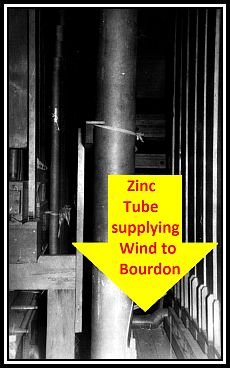 The Yellow Arrow points to the Wind Trunking made of Zinc Tubing
The Yellow Arrow points to the Wind Trunking made of Zinc Tubing
Wind-Trunking can take many forms: soldered zinc tubing, flexible card-based tubing and even square-section wooden box-style trunking (which has to be glued and screwed together to make it airtight).
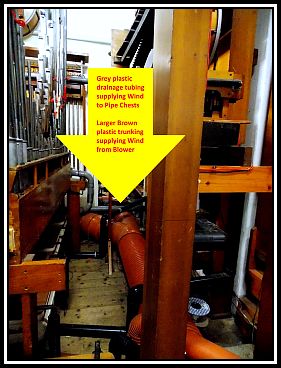 Two types of Plastic Tubing supplying wind to Pipe Chests
Two types of Plastic Tubing supplying wind to Pipe Chests
Modern plastic tubing, as used in plumbing, is very popular since it is cheap to buy, can be sourced in many lengths and diameters and has a range of bends and angle-pieces.
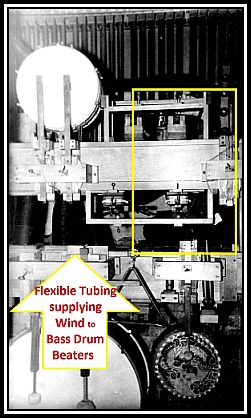
The various tubings can then be glued together with solvent to provide lightweight airtight connections. A major problem with the zinc tubing was the frequency with which it was trodden on whilst someone was crawling around the chambers, which would often result in it being split and so lead to an air leak. Should the zinc tubing become squashed, the result would generally be a reduction of flow or wind pressure;
XYLOPHONE: This is a series of tuned wooden bars on the order of the Marimba, but not as liquid in tone. It produces a dry wooden tone and makes for an excellent percussion instrument.
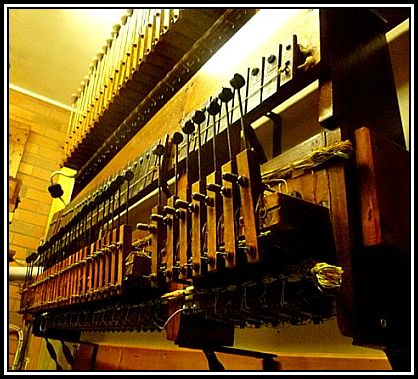 Xylophone
Xylophone
(Kevin Grove State College, Queensland)
—ooOoo—
I recommend that the reader take a few minutes to watch the excellent video,
where the reader will get to see the organ behind the scenes.
——oooOOOooo——
ACKNOWLEDGEMENTS
I would like to thank Mr. Eugene Stuart Barrie for providing the foundation of my Glossary.
I would also like to thank Mr. Wayne Ivany & FRIENDS OF BEER WURLITZER for providing explanations, photographs
and for helping to make this material informative, comprehensive and above all clear.
I am extremely grateful to Mr. Dave P. Cresswell for providing some of the definitions given here.
I would like to thank Mr. Simon Glenhill for his help and for providing the photograph of a Pneumatic
I would also like to thank Mr. Paul Bland for providing some of the definitions, helpful discussion and several photographs.
I am very grateful to Mr. Michael Wooldridge for his help in clarifying a number of the definitions that appear here.
——oooOOOooo——
Click here to go to PART ONE: INTRODUCTION
——oooOOOooo——
Click here to go to PART TWO: BUILDERS OF THE THEATRE ORGANS
——oooOOOooo——
Click here to go to PART THREE:
THE ORGANS & THE ORGANISTS of THE GRANADA THEATRE CIRCUIT
——oooOOOooo——
Click here to go to the PART FOUR:
THE ELECTRIC-PNEUMATIC SYSTEM OF THE THEATRE ORGAN
——oooOOOooo——
Click here to go to the THE THEATRE ORGAN HOME PAGE
——oooOOOooo——
Click here to go to the THE WANAMAKER ORGAN – HOME PAGE
——oooOOOooo——
Click here to return to the TABLE OF CONTENTS
——oooOOOooo——

